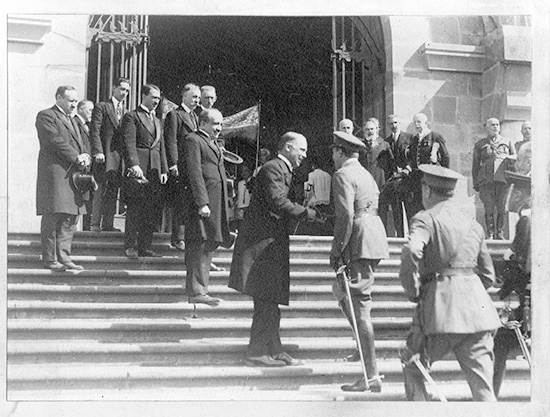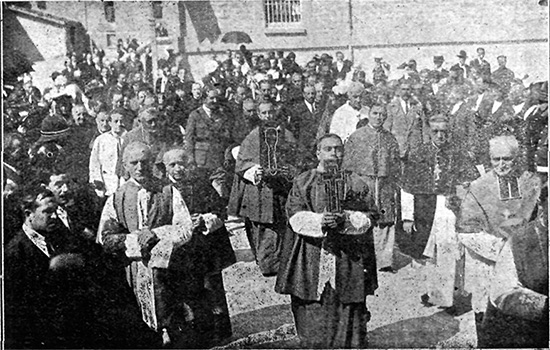Images in Navarra of the III Centenary of the canonization of Xavier (II)

Photo /Various photos of the royal visit on September 23, 1922. Photo from Fr. Eguía's chronicle.
The royal visit to the castle of Javier a century ago: September 23, 1922
The celebration of the III Centenary of the canonization of St. Francis Xavier counted on numerous acts that were enhanced with his reliquary, brought from Rome, together with the Christ of the Crab, arrived from the Royal Palace of Madrid. Between September 21 and 25, 1922, the celebration of a solemn triduum arranged by the Provincial Council, the National congress of the Missionary Union of the Clergy, the official pilgrimage to Javier and the great civic-religious parade through the streets of the capital of Navarre took place. On the 23rd, the official pilgrimage to Javier was held, with the Provincial Council and the Deputations of the Basque Provinces at the head, as well as numerous delegations from other localities, and several prelates. The presence of Alfonso XIII, who arrived at the castle by car, coming from San Sebastian, added great importance to the festivities. The pilgrimage to Javier was a prologue to the workshop experienced in Pamplona on September 24, which we already dealt with in another entrance in this blog.

Public in the vicinity of the castle. Photo file General of Navarra
The reports that we know are laudatory, overloaded and somewhat pompous, in full harmony with the period, pondering some values around the Navarrese saint and, of course, the authorities who participated in the acts. They are texts that still breathe of past times, provide countless names of authorities and translate a phenomenon of religious exaltation with a propagandistic intentionality to empathize with the readers and lead them towards ideals, pointing out behaviors to follow, in many cases.
Alfonso XIII and the authorities in Javier
The program designed for the celebrations had as one of the most relevant acts the "Official Pilgrimage to the Castle of Javier", prepared with all care and detail by the board commissioned by the Provincial Council of Navarre, with the participation of city councils and parishes of the region. Cardinals, archbishops and bishops were invited, as well as the deputies in the Cortes and the Deputations of the Basque provinces.
The king arrived from the capital of Guipuzcoa. His reception in Irurzun, was at position of the civil governor, the vice-president of the Diputación and some deputies. From there they went by car to Javier, through Aoiz, so as not to interfere with the road to Monreal where the bulk of the pilgrimage was coming. In Lumbier and Liédena floral arches had been prepared by the neighbors and the route was guarded by the civil guard, forest rangers and "other officials of the authority". As it passed through Sangüesa it was received massively, with the ringing of bells, the roar of numerous rockets and the sounds of the royal march, played by the Band of Music. With its local authorities in front, it entered under canopy in the parish of Santa María and venerated Our Lady of Rocamador.

Authorities in the castle of Javier. Photo file General of Navarra
The editor of El Pensamiento Navarro affirmed that Navarre was that day on the routes that led to the small homeland of the Navarrese saint, on horseback, on foot and above all in a caravan that brought with it much popular expectation and produced "a singular impression on the people of the towns", since "all Navarre is on the roads, on the way to Javier moved by the same spring, faith".
In Javier everything was ready since six in the morning, with the singing of the rosary by the students of the Jesuits. In El Pensamiento Navarro the work of the board of the Centenary is praised, especially of its manager maximum and soul of those celebrations, Ignacio Baleztena, who was from the first hour taking care of the smallest detail. In a paragraph of Father Eguía's chronicle, we read: "Don't you see the consoling spectacle of the Pamplona carriage? ... Monreal, Idocin, Navascués, Sangüesa, all there are ready for the popular expectation. One and another caravan of cars, or of any carriages and cavalcades, electrifies them, puts them in tension and paints on their faces the most expressive signs of gratitude and joy. The cardinal purpurate, the ecclesiastical prelates, make them bow their foreheads with devotion".
The entire town of Javier was decorated for the occasion. The report of the Jesuit Constancio Eguía states: "His Majesty was also very pleased to see the patriotic attire displayed by our buildings and the whole town. The Apostolic School appeared covered with hangings in the openings, alternating the national and Navarre colors. The castle unfurled its flags to the winds. Of the three towers, the pontifical flag was hoisted on the largest, on the middle one, called San Miguel, the Spanish flag, and on the eastern or lower one, the flag of Navarre. The battlements of the bastions were hung with three flags of France, Portugal and Japan, in honor of the three national consuls who attended the celebration. From the windows hung coats of arms of Navarre". In the area of the gables were hung bows, tapestries of the house of Javier and of the Spanish kingdoms.

Mayors of Roncal who attended the celebration. Photo of the chronicle of Fr. Eguía
The reception in Javier, at about eleven o'clock in the morning, is described in different chronicles as enthusiastic, with thousands of people waiting, bells and fireworks. The king was accompanied by the president of the committee of Ministers and various officials of his civil and military household. He was received at the door of the Jesuit residency program by the Provincial and President of the Society of Jesus, the Provincial Council and civil and ecclesiastical authorities. After a brief rest inside, the solemn Mass was celebrated in front of an altar presided over by the canvas of Javier painted by Elías Salaverría, at the sides of which the mace bearers of the Provincial Council were placed. Julio Arrieta, "of whose artistic taste there is no doubt, was at the same level as always: order and beauty presided over the arrangement of the altar and the dais". The aforementioned Luis Arrieta was in charge of the design of the medals of the commemoration of the III Centenary in Navarre and of the pilgrim's medal, as well as of the drawing that illustrates the Program of the Festivities to be celebrated, beautifully illustrated by Artes Gráficas de Pamplona in that year of 1922.
Rich damasks were brought from the Diputación and the five large Flemish tapestries, valued at that time at one million pesetas. position The musical part was performed by the Orfeón Pamplonés, under the direction of Remigio Múgica, who interpreted the German mass dedicated to the saint. However, the Kyries and the Gloria had to be improvised by the students of the Apostolic School together with some Jesuits, due to the delay in the arrival of the musical group from Pamplona, which joined the celebration after the Credo. The list of prelates, nobles and military and political authorities is very long and is provided by Diario de Navarra, on the first page of the issue corresponding to September 24, 1922. At the end of the religious official document , the Official Hymn of the centenary was interpreted, composed by the master Joaquín Larregla and lyrics by Alberto Pelairea, with the participation of the crowd, because the melody "was already becoming popular".

Processional parade in Javier with the reliquary arm and the crab cross. Photo Marín published in La Avalancha.
After the mass, the retinue visited the Apostolic high school and the castle, stopping before the famous Crucifix that sweated blood during the life of the saint. At that moment, according to the chronicle of Diario de Navarra, the liberal deputy Valentín Gayarre, came forward and said to the king: "Sir, we are before a miraculous Christ that according to the tradition flowed blood when the saint was in danger; and I take advantage of the occasion to ask your majesty for the pardon of the prisoner Pedro Abós". The monarch replied: "If only this Christ would resurrect the dead! In any case, after some adhesions to the petition, such as that of the director of ABC -Torcuato Luca de Tena-, and a royal insinuation, the president of the committee of Ministers committed himself to study the matter when he had the opportune transcript. It should be noted that the ABC newspaper was repeatedly involved in the petition for that pardon. The aforementioned Pedro Abós, nicknamed "el Bolo", would be pardoned from his death sentence in December 1922. The prisoner had been convicted of murdering his wife Valentina Martínez Sáinz, during the San Blas festivities in Lodosa the previous year, on February 5, 1921.
The official banquet was attended by numerous authorities and was entertained from outside by La Pamplonesa. The tables were richly decorated with flowers. The pilgrims were presented with personal bags "with abundant portions of cold cuts, eggs and chicken, desserts, bread and wine". The monarch received the mayors of Roncal with whom he conversed, taking an interest in different aspects of the Valley. As a curious fact, the names of all the representatives of the seven villages of the Valley, who attended with their traditional costumes and flags, are also provided. The mayor of Isaba, Dositeo Ochoa, gave this brief speech: "Sir: One of the highest honors for the commission of the seven Roncal villages is to greet Your Majesty and offer your respects. The Roncal Valley, which never backs down, is with Spain, with Navarre and with its King Alfonso XIII. Long live the King!
To find out more
Diario de Navarra, September 24, 1922, pp. 1 and 2.
EGUÍA RUIZ, C., Reliquias de San Ignacio de Loyola y San Francisco Javier. Su recorrido triunfal por España, Madrid, Blass, S. A. Tipográfica, 1924.
El Pensamiento Navarro, September 24, 1922, p. 1.
